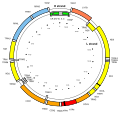Hypervariable region
Hypervariable regions (HVRs), also known as variability regions, are sections of proteins and DNA where the sequence of nucleotides or amino acids varies significantly from one individual to another. These regions are of particular interest in the fields of genetics, molecular biology, and immunology because they are critical for the diversity of antibodies, the specificity of T-cell receptors, and the variability in certain pathogens which helps them evade the immune system.
Overview[edit]
Hypervariable regions in the DNA are often used in research and forensic science for DNA fingerprinting to identify individuals or genetic relationships due to their high variability between unrelated individuals. In proteins, these regions are important for the adaptive immune system, particularly in the antigen-binding sites of antibodies where they allow for the recognition of a vast array of pathogens.
Genetic Basis[edit]
The genetic basis of hypervariable regions involves mechanisms such as somatic recombination, which shuffles gene segments in the immune cells (B cells and T cells), and somatic hypermutation, which introduces mutations at a high rate in the variable regions of the antibody genes. These processes generate a diverse repertoire of immune cells, each capable of recognizing a different antigen.
Clinical Significance[edit]
In the clinical context, the study of hypervariable regions has implications for vaccine development, cancer immunotherapy, and the diagnosis of certain diseases. For example, analyzing the hypervariable regions of Human Immunodeficiency Virus (HIV) can help in designing vaccines that target the most conserved parts of the virus's envelope protein.
Hypervariable Regions in Pathogens[edit]
Some pathogens, such as HIV and the hepatitis C virus, have hypervariable regions in their genomes that enable them to rapidly evolve and escape immune detection. This presents a significant challenge for the development of effective vaccines and treatments.
Research and Applications[edit]
Research into hypervariable regions is ongoing, with new technologies such as next-generation sequencing (NGS) providing detailed insights into the variability and evolution of these regions. Such studies are crucial for understanding the mechanisms of immune response and for the development of new therapeutic strategies.
See Also[edit]
Hypervariable_region[edit]
-
Map of the human mitochondrial genome
Ad. Transform your life with W8MD's Budget GLP-1 injections from $75


W8MD offers a medical weight loss program to lose weight in Philadelphia. Our physician-supervised medical weight loss provides:
- Weight loss injections in NYC (generic and brand names):
- Zepbound / Mounjaro, Wegovy / Ozempic, Saxenda
- Most insurances accepted or discounted self-pay rates. We will obtain insurance prior authorizations if needed.
- Generic GLP1 weight loss injections from $75 for the starting dose.
- Also offer prescription weight loss medications including Phentermine, Qsymia, Diethylpropion, Contrave etc.
NYC weight loss doctor appointmentsNYC weight loss doctor appointments
Start your NYC weight loss journey today at our NYC medical weight loss and Philadelphia medical weight loss clinics.
- Call 718-946-5500 to lose weight in NYC or for medical weight loss in Philadelphia 215-676-2334.
- Tags:NYC medical weight loss, Philadelphia lose weight Zepbound NYC, Budget GLP1 weight loss injections, Wegovy Philadelphia, Wegovy NYC, Philadelphia medical weight loss, Brookly weight loss and Wegovy NYC
|
WikiMD's Wellness Encyclopedia |
| Let Food Be Thy Medicine Medicine Thy Food - Hippocrates |
Medical Disclaimer: WikiMD is not a substitute for professional medical advice. The information on WikiMD is provided as an information resource only, may be incorrect, outdated or misleading, and is not to be used or relied on for any diagnostic or treatment purposes. Please consult your health care provider before making any healthcare decisions or for guidance about a specific medical condition. WikiMD expressly disclaims responsibility, and shall have no liability, for any damages, loss, injury, or liability whatsoever suffered as a result of your reliance on the information contained in this site. By visiting this site you agree to the foregoing terms and conditions, which may from time to time be changed or supplemented by WikiMD. If you do not agree to the foregoing terms and conditions, you should not enter or use this site. See full disclaimer.
Credits:Most images are courtesy of Wikimedia commons, and templates, categories Wikipedia, licensed under CC BY SA or similar.
Translate this page: - East Asian
中文,
日本,
한국어,
South Asian
हिन्दी,
தமிழ்,
తెలుగు,
Urdu,
ಕನ್ನಡ,
Southeast Asian
Indonesian,
Vietnamese,
Thai,
မြန်မာဘာသာ,
বাংলা
European
español,
Deutsch,
français,
Greek,
português do Brasil,
polski,
română,
русский,
Nederlands,
norsk,
svenska,
suomi,
Italian
Middle Eastern & African
عربى,
Turkish,
Persian,
Hebrew,
Afrikaans,
isiZulu,
Kiswahili,
Other
Bulgarian,
Hungarian,
Czech,
Swedish,
മലയാളം,
मराठी,
ਪੰਜਾਬੀ,
ગુજરાતી,
Portuguese,
Ukrainian
